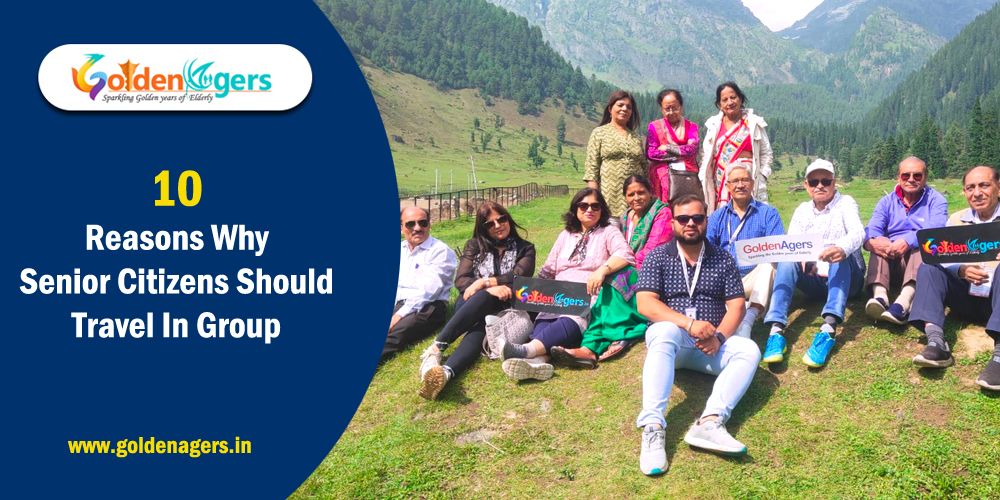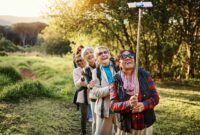Senior citizens travel groups offer a unique blend of adventure, relaxation, and cultural immersion, catering to the specific needs and preferences of older travelers. These groups provide a supportive and enjoyable environment for exploration, allowing individuals to experience new destinations and cultures without the stress of independent travel planning. This guide explores the various facets of senior citizen travel groups, from planning and logistics to activities and marketing strategies, ensuring a comprehensive understanding of this growing sector of the tourism industry.
The diverse range of group types, from relaxing cruises to adventurous expeditions, caters to a wide spectrum of interests and physical abilities. Careful planning, including accessible transportation and accommodation, is crucial to ensure a comfortable and memorable experience for all participants. Effective marketing strategies are also vital in attracting potential travelers and building trust within this demographic.
Types of Senior Citizen Travel Groups
Choosing the right senior citizen travel group depends heavily on individual preferences and desired activity levels. Understanding the different types available allows for a more tailored and enjoyable travel experience. This section will explore various options, highlighting their unique characteristics and ideal participants.
Senior citizen travel groups cater to a wide spectrum of interests and physical capabilities. From adventurous explorations to relaxing retreats, there’s a perfect fit for everyone seeking a fulfilling travel experience in their later years.
Categorizing Senior Citizen Travel Groups by Activity Level
Senior citizen travel groups are broadly categorized based on their activity level, each offering a distinct experience. This categorization helps individuals choose a trip that aligns with their physical capabilities and travel preferences.
| Group Type | Activity Level | Typical Itinerary Example | Target Audience |
|---|---|---|---|
| Relaxation & Wellness Retreat | Low | Spa treatments, gentle yoga, leisurely walks, guided meditation sessions, quiet time for reflection, comfortable accommodations with accessible amenities. Focus on rest and rejuvenation. | Individuals seeking a tranquil escape, those recovering from illness or surgery, those who prefer a slower pace of travel. |
| Cultural Immersion Tour | Moderate | Visits to historical sites, museums, and local markets; participation in cultural events and workshops; opportunities to interact with locals; comfortable pacing with scheduled rest periods; potentially includes some walking tours. | Individuals interested in history, art, and different cultures; those who enjoy learning and exploring new places at a moderate pace. |
| Active Adventure Tour | High | Hiking, biking, kayaking, or other physically demanding activities; longer travel days; potentially involves staying in more rustic accommodations; requires a good level of fitness and stamina. | Individuals with a high level of physical fitness and an adventurous spirit; those who enjoy challenging themselves physically. |
| Cruise Vacation | Low to Moderate (variable) | Onboard activities, shore excursions (varying in activity level), onboard dining and entertainment; accessibility features often available. The level of activity depends on the chosen excursions and personal preference. | Individuals seeking a combination of relaxation and structured activities; those who prefer a convenient and comfortable travel experience with varied options. |
Planning and Logistics for Senior Citizen Travel Groups
Careful planning and meticulous logistics are paramount for ensuring a smooth and enjoyable travel experience for senior citizen groups. Factors such as pacing, accessibility, and health considerations must be prioritized to create a trip that is both enriching and comfortable. This section details key aspects of planning and executing a successful senior travel experience.
Sample 7-Day European River Cruise Itinerary
This itinerary prioritizes gentle pacing, accessibility, and ample rest periods, ideal for senior travelers. The focus is on manageable activities and comfortable accommodations.
| Day | Activity | Accessibility Notes | Rest Period |
|---|---|---|---|
| 1 | Arrival in Amsterdam, embarkation, welcome dinner | Accessible embarkation points and ramps provided. | Evening relaxation time. |
| 2 | Amsterdam canal cruise, guided walking tour (optional, shorter route available) | Accessible canal boat, slower pace walking tour option available. | Afternoon free time for rest. |
| 3 | Travel to Cologne, Germany. Guided walking tour of Cologne Cathedral (accessible entrance). | Accessible coach transportation, elevator access to Cathedral. | Afternoon rest or optional visit to a local café. |
| 4 | Rhine River scenic cruise, onboard lectures and entertainment | Accessible onboard facilities, seating available. | Afternoon dedicated to relaxation, onboard activities are optional. |
| 5 | Visit to a local vineyard (accessible transport), wine tasting (optional) | Accessible transportation to and from the vineyard. | Afternoon free time, quiet time encouraged. |
| 6 | Travel to Heidelberg, Germany. Visit Heidelberg Castle (accessible areas available), free time in town. | Accessible coach transportation, designated accessible areas in the Castle. | Evening at leisure. |
| 7 | Disembarkation in Heidelberg, departure | Accessible disembarkation. | Travel day, rest encouraged before departure. |
Travel Insurance and Emergency Preparedness
Comprehensive travel insurance is crucial for senior travel groups. It should cover medical emergencies, trip cancellations, lost luggage, and repatriation. A detailed emergency plan, including contact information for local emergency services and a designated group leader responsible for coordinating responses to unforeseen events, is also essential. This plan should also include pre-existing condition documentation for each participant. Consider including a readily accessible medical kit with common medications and supplies.
Managing Group Dynamics and Addressing Health Concerns
Maintaining open communication is key to managing group dynamics. Regular check-ins with group members can help identify and address potential issues early on. Having a designated point of contact for medical concerns and providing readily available information on local healthcare facilities can ensure swift response to any health issues. The itinerary should be flexible enough to accommodate unexpected needs. Pre-trip health questionnaires can assist in identifying potential risks and ensuring appropriate accommodations. Having a member of the group, or a hired professional, trained in basic first aid can prove invaluable.
Accommodation and Transportation for Senior Travelers
Choosing the right accommodation and transportation is crucial for a smooth and enjoyable travel experience for senior citizens. Factors such as accessibility, comfort, and convenience significantly impact their overall well-being and enjoyment during the trip. Careful consideration of these elements ensures a positive and memorable journey for all participants.
Senior-Friendly Hotel Characteristics
Ideal senior-friendly hotels prioritize accessibility and comfort. This translates to features that minimize physical strain and maximize ease of movement. Rooms should be spacious enough to accommodate wheelchairs or walkers, with wide doorways and hallways. Bathrooms require grab bars, roll-in showers, and adjustable showerheads. Well-lit corridors and clear signage are essential for navigation. Consider amenities like elevators that are readily accessible and easy to use. The availability of comfortable seating areas in common spaces, along with readily available assistance from hotel staff, also contributes to a positive experience. Hotels offering accessible dining options and on-site assistance programs are particularly valuable.
Transportation Options for Senior Travelers
Several transportation modes cater to the needs of senior travelers, each with its advantages and disadvantages. Buses offer a cost-effective option for group travel, providing ample space for luggage and often including amenities like restrooms. However, extended bus journeys can be tiring for some seniors. Trains, on the other hand, offer a more comfortable and scenic journey, with the option to move around and stretch. However, train travel might be more expensive and less flexible than bus travel. Private car services offer the most personalized and convenient option, with direct transport and the ability to tailor the journey to the group’s preferences and pace. However, this option is generally the most expensive.
Accessibility Features for Transportation and Accommodation
Careful consideration of accessibility features is paramount when planning travel for senior citizens. These features ensure a safe and comfortable experience for everyone.
- Accommodation: Wide doorways and hallways, grab bars in bathrooms, roll-in showers, ramps or elevators, accessible dining areas, well-lit corridors, clear signage, emergency call buttons in rooms.
- Bus Transportation: Designated seating for seniors, accessible restrooms, ramps or lifts for boarding, wider aisles, secure luggage storage, assistance with boarding and disembarking.
- Train Transportation: Accessible restrooms, ramps or lifts for boarding, wider aisles, designated seating areas, assistance with boarding and disembarking, clear announcements and signage.
- Private Car Transportation: Vehicles equipped with ramps or lifts, ample space for wheelchairs or walkers, assistance with loading and unloading, adjustable seating.
Activities and Experiences for Senior Citizen Travel Groups
Designing engaging and appropriate activities is crucial for a successful senior citizen travel experience. The goal is to cater to diverse interests and physical abilities, ensuring everyone feels included and enjoys the trip. A well-planned itinerary balances relaxation with stimulating activities, fostering camaraderie and creating lasting memories.
Age-Appropriate and Engaging Activities
Offering a range of activities ensures participation from all group members. Consider options that cater to different levels of physical activity and interests. For example, gentle walking tours of historical sites can be paired with relaxing afternoon tea sessions. Those who prefer more active pursuits might enjoy guided hikes with manageable inclines or gentle cycling excursions. For less mobile participants, engaging lectures, cultural demonstrations, or craft workshops provide enriching alternatives.
- Gentle Walking Tours: Exploring historical districts or botanical gardens at a leisurely pace.
- Cooking Classes: Learning local culinary techniques and enjoying the fruits of their labor.
- Museum Visits: Exploring art, history, or science museums with ample rest breaks.
- Cultural Performances: Attending local music, dance, or theatrical performances.
- Game Tournaments: Engaging in friendly competitions like bridge, bingo, or trivia.
- Relaxation and Wellness Activities: Spa treatments, yoga sessions, or simply enjoying quiet time in beautiful surroundings.
Benefits of Cultural Immersion Experiences
Incorporating cultural immersion significantly enhances the senior travel experience. Direct interaction with local cultures broadens perspectives, stimulates cognitive function, and promotes a sense of connection and understanding. This could involve visiting local markets, attending traditional festivals, interacting with artisans, or participating in cultural workshops. The experience fosters personal growth and provides rich conversational fodder long after the trip concludes. For example, a visit to a local pottery workshop in Tuscany allows participants to not only learn about the craft but also interact with the artisan, hearing their stories and gaining a deeper appreciation for Italian culture.
Creating a Visually Appealing Brochure
A well-designed brochure is essential for attracting potential travelers. The brochure for a sample senior travel package to the Tuscan region of Italy might feature high-quality images showcasing rolling hills, charming villages, and sun-drenched vineyards. The layout should be clean and easy to read, with large, clear fonts and ample white space.
The front cover could feature a captivating photograph of a picturesque Tuscan landscape, perhaps with a charming villa in the background. The title, “Tuscan Delights: A Senior’s Journey Through Italy,” would be prominently displayed in an elegant font. Inside, each page would showcase a different aspect of the tour, with compelling images and concise descriptions. For instance, a page dedicated to activities could include photos of participants enjoying a cooking class, exploring a local market, and relaxing by a pool. Another page could highlight accommodation, featuring images of the comfortable hotel rooms and common areas. A map of the itinerary would provide a visual representation of the destinations. The back cover would include contact information and a call to action, encouraging readers to book their unforgettable Italian adventure. The color palette should be warm and inviting, reflecting the beauty of Tuscany, perhaps incorporating shades of ochre, terracotta, and olive green.
Marketing and Promotion of Senior Citizen Travel Groups
Successfully marketing senior citizen travel groups requires a strategic approach that resonates with the target demographic’s needs and preferences. Understanding their concerns, desires, and communication channels is crucial for effective promotion and building a loyal clientele. This involves crafting compelling marketing materials, leveraging social media, and prioritizing the establishment of trust and credibility.
Effective marketing hinges on highlighting the unique aspects of senior travel groups and differentiating them from general travel options. This involves emphasizing the safety, convenience, and social aspects inherent in group travel designed specifically for seniors. The value proposition should clearly articulate the benefits, such as stress-free planning, engaging activities tailored to seniors’ interests, and the opportunity for social interaction and companionship.
Marketing Materials for Senior Travelers
Marketing materials should focus on the ease and enjoyment of senior group travel. Brochures and catalogs could feature high-quality photographs depicting happy seniors participating in enriching activities. These visuals should showcase comfortable accommodations, engaging excursions, and opportunities for socialization. The text should emphasize the convenience of pre-planned itineraries, the expertise of experienced tour guides, and the peace of mind offered by a well-organized travel experience. Furthermore, testimonials from previous travelers, highlighting positive experiences, would add credibility and reassurance. Consider including a detailed itinerary showcasing daily activities, and clear pricing information, including any additional costs or optional excursions.
Social Media Strategy for Senior Citizen Travel Groups
Reaching senior citizens effectively on social media requires a targeted approach. While some seniors actively use platforms like Facebook, Instagram, and even TikTok, the strategy should also consider platforms frequented by this demographic. Facebook groups dedicated to retirement or travel could be valuable avenues for advertising. Content should be visually appealing, utilizing high-quality photos and videos showcasing the experiences offered. Regularly posting engaging content, such as travel tips, inspirational stories, and behind-the-scenes glimpses of past trips, will help build a community and generate interest. Paid advertising on these platforms, specifically targeting users within a certain age range and interest groups, can be an effective way to reach potential clients. It’s important to use clear and concise language, and avoid overly technical jargon or complex formatting.
Building Trust and Credibility with Potential Clients
Building trust is paramount when marketing senior citizen travel groups. This requires transparency and a commitment to safety and customer satisfaction. Providing detailed information about itineraries, accommodation standards, and emergency procedures builds confidence. Displaying certifications, licenses, and affiliations with reputable organizations helps establish credibility. Positive reviews and testimonials from past clients are powerful tools for demonstrating the quality of service and experiences provided. A professional and responsive customer service approach, readily addressing inquiries and concerns, further strengthens trust and reassures potential clients. Consider including contact information for easily accessible communication, and ensure prompt responses to any inquiries.
Ending Remarks
Senior citizens travel groups represent a significant and growing market within the travel industry. By understanding the unique needs and preferences of this demographic, travel operators can create enriching and fulfilling experiences that foster independence, social connection, and lasting memories. Careful attention to planning, accessibility, and marketing will be crucial in ensuring the continued success and growth of this sector, providing valuable opportunities for both travelers and businesses alike.




